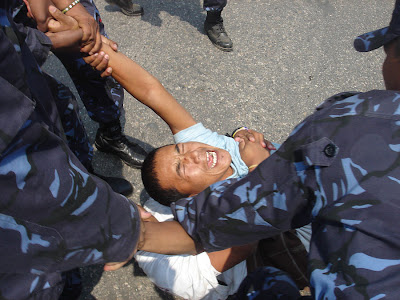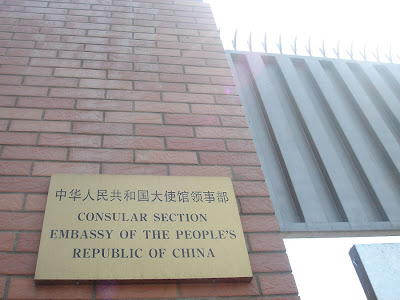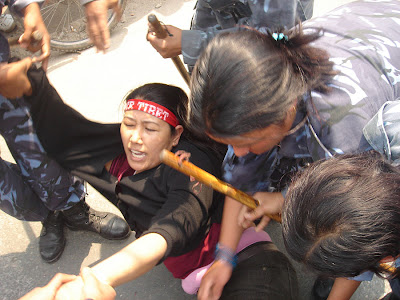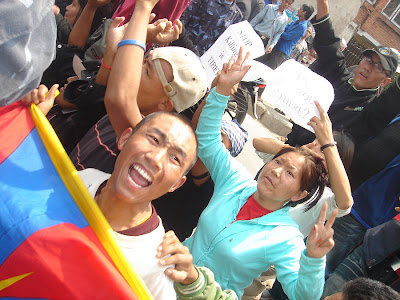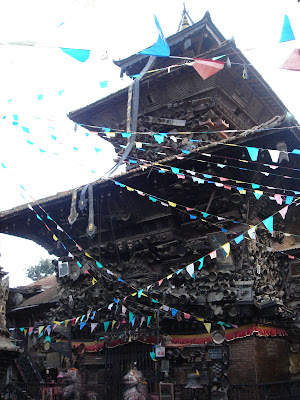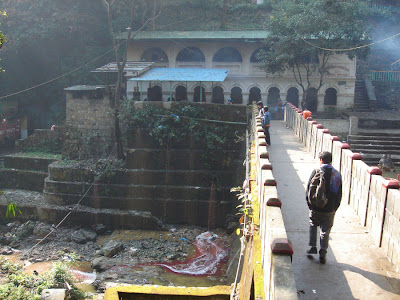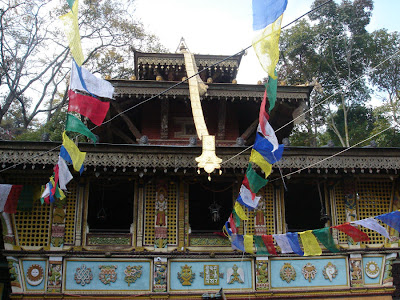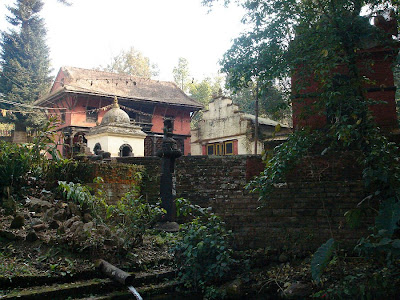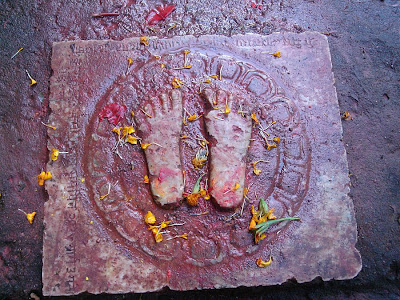Handy Nepali PhrasesBhaktapur, Nepal
Nepalis are generally easy people (unless they are agitating for a separate Nepali-speaking state in Sikkim, I suppose....or unless they are
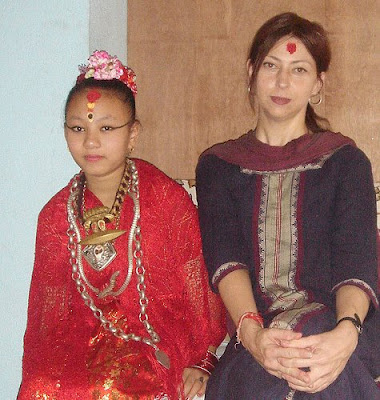
extorting money from local businessmen....or sacrificing animals...or kidnapping wealthy Indians...or beating up Tibetan protestors.
Okay, I'm out)
... well, what I was going to say before my generalization was so rudely interrupted, was "Nepalis are generally easygoing people and Nepali is an easy
language to learn." It's like a softer
Hindi, with all the sharp edges rounded off. Just put Os where Hindi has As, Cha or Ho where Hindi has Hai, Na where Hindi has Nahin, and the suffix -nus where Hindi has -jiye and there you go - you're speaking Nepali.
(Not exactly, but pretty close.)
Oh yeah, and to speak Nepali, you have to drop the obligatory bossy attitude of Hindi. And the nasality. You have to smile to speak proper Nepali. You have to look down your nose at someone to speak proper Hindi.
It's
Nepali and Hindu new year, and just days after the election, the mood here in the traditional Newar town of
Bhaktapur is just delicious. Today was the last of a luxurious week of
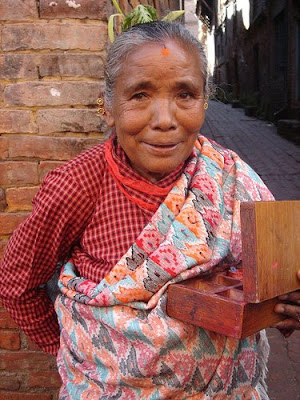
holidays declared because of the election. The new year's tradition is to wear a brand-new sari or other outfit (for unmarried girls, that is anyone under 20, it's a new kurta-salwar set; for young men it's a WWF t-shirt and brand new stonewashed jeans) - wear your new new year's clothes and stroll around town arm in arm with family, chatting and stopping on the corner to eat homemade ice cream. (It looks homemade to me... I stick with the
juju dahi or King's Curd for which Bhaktapur is famous.)
Naya barsha ko shubh kamana! will win you a lot of points right now. It means "happy new year."
First of all, you have to get used to addressing hierarchically, and as family. There is a definite pecking order involving age, caste and other status markers; but for foreigners, who this mostly means acknowledging seniors, peers and youth.
Elder men (elder to you) are addressed as
Dai, or perhaps
Kaka (uncle). A man your age or younger is
Bhai. A very elder man is
Huzoor-bho (respected father). Elder women are
Didi (big sister),
Kaki (auntie) or
Huzoor-amma (respected mother) , very elder women are
Ajima (grandmother), and young ladies are
Bahinee (daughter).
"Huzzoor!" is the most respectful way to answer the phone or address an elder or superior. It just means something like, "respect." Otherwise, people normally say
"Namaste" here to foreigners. People here actually say namaste and put their folded hands, up like praying. Only a few people in tourist places do that in India.
Let's start with practical things.

"Kalaam koti yo?" means, "how much is this ink pen."
Common numerical responses include
"das rupiyah," (ten rupees)
"pandara" (pron. 'pundarra') = 15 rupees
"bis" (beese) = twenty
"tis" (tees) = thirty
Ek sau (one hundred) or Ek sau pachas (150).
"Mahango chha!" means, "your price is too expensive!"
"Duitaa (dwee-taa)
kalaam tis rupiyah dinus." = Please give me 2 ink pens for thirty rupees.
"Shasto price dinus" = give me the cheap price.
The shop owner may counter with
"Yo shasto price chha." ("This is a cheap price." To which you retort indignantly,
"Shasto chhaina!" --(it's not cheap! )
Theek (pron. teak, like teakwood)
chha! means, okay, all right or good!
Theek chhaina (pron. "chinaa") naturally means, "this is not okay." I find myself saying this more often than I would like....
and the classic Nepali phrase,
"Ke garne? " (pronounced "kay garnay")
means, "what to do?" and translates as, "I give up - it's someone else's job. " Or, "this is NOT going to get fixed or done today so relax and forget about it."
Dinus (deenus) is polite for "please give."
Linus (lee-nus) is polite for "please take." In "street" Nepali these polite forms are little used - there are more truncated forms - but I prefer them. I figure as a newcome to the language I should be more polite.
Oh, that reminds me of the useful polite command forms, which usually end in -nus (noose).
Bussnus = Please sit. I often have to use this as shopkeepers tend to jump up the second they see you even look in their doorway.
Sodhnnus = please listen.
Bolnus = please tell me
Lekhnus = please write. And so on.
"Nepal maa, saarbhai jaan dehri ramro" = Here in Nepal, everyone is very good. Another diplomatic point-scorer.
"Taxi khali chha?" = is this taxi free?
Answers: Chha! (yes it is!)
Chhaina! (pron. chinaa) - (no it's not!) - and these are usually uttered with an exclamation point.
"Maa airport jaanchu" means, I am going to the airport.
"Meter maa theek chha?" means, "will you go on the meter?"
"Tapai ko naam ke ho?" = what is your name. But for children, you should use the diminutive
"Timi lai naam ke ho?"
"Yo deva naam ke ho?" is one I use all the time when visiting temples. It means, "What is the name of this deity?"
"Yo bus Bhaktapur jaane?" means, is this bus going to Bhaktapur?
Bhai, yahe (yahay) rokiyay is a polite way to tell your taxi driver "stop here, brother."
"Bholi parsi chhaina -- Ahilay! Ahilay!" is very useful indeed. ("Tomorrow tomorrow NO - TODAY! TODAY!)
"Tapai lai vetera malai dehri kusi lagyu" is "I am very pleased to meet you."
More practical ones:
Koti kero bundho garne? (what time do you close here?)
and
Koti kero kullchha garne? (what time do you open?)
Of course, you have to understand the answer - but everyone knows number up to ten at least. (Nothing opens before 10, or
Das Bhaje.)
Speaking of which, it's
ahht bhaje (8pm) and time to close here in sleepy Bhaktapur.
 But my favourite is the little tiny Han Kook Sarang, in the same courtyard with Tamas Lounge and Pink Palace opposite the RoadHouse Restaurant.
But my favourite is the little tiny Han Kook Sarang, in the same courtyard with Tamas Lounge and Pink Palace opposite the RoadHouse Restaurant.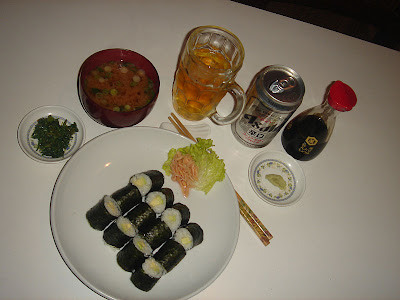 My personal idea of heavenly cuisine is at Momo Tarou. Again, there are many excellent Japanese restaurants in town...but I like this small, friendly place near Bhagavati Bahal just above Thamel Chowk.
My personal idea of heavenly cuisine is at Momo Tarou. Again, there are many excellent Japanese restaurants in town...but I like this small, friendly place near Bhagavati Bahal just above Thamel Chowk. 




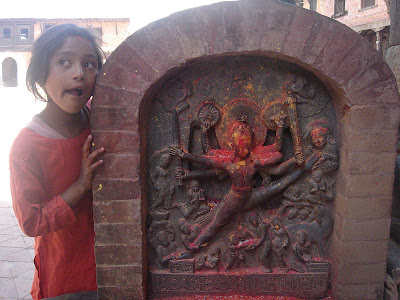


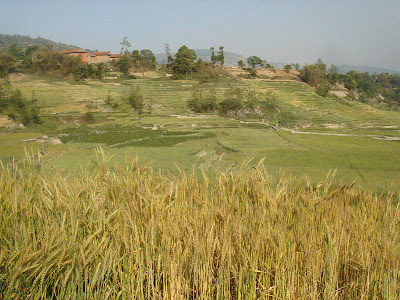



 Despite the fact that I can't read it, I think the stone below is my favorite part of Changu. In the ancient and now disused Licchavi script, it supposedly relates the story of how a Licchavi king dissuaded his mother from sati, or widow's ritual suicide on the funeral pyre of her husband, and instead persuaded her to stay with him among the living because he would miss her. (Some proof that, despite what many would like to claim, sati was real, not an invention of the British or anti-Hindu propagandists.)
Despite the fact that I can't read it, I think the stone below is my favorite part of Changu. In the ancient and now disused Licchavi script, it supposedly relates the story of how a Licchavi king dissuaded his mother from sati, or widow's ritual suicide on the funeral pyre of her husband, and instead persuaded her to stay with him among the living because he would miss her. (Some proof that, despite what many would like to claim, sati was real, not an invention of the British or anti-Hindu propagandists.)



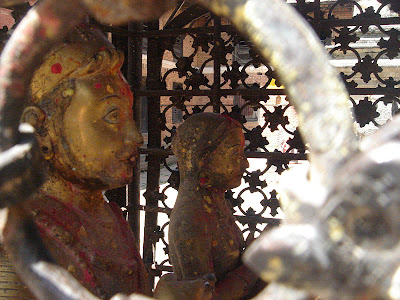
 After a dreadful and very overpriced lunch at the neat, tidy garden style restaurant near the front gate (don't be fooled by the appearance - they do have a bathroom, though), we elected to walk the hour and half back down to Bhaktapur town, through the pine forest (the best part), windy wheat fields, and dusty small towns.
After a dreadful and very overpriced lunch at the neat, tidy garden style restaurant near the front gate (don't be fooled by the appearance - they do have a bathroom, though), we elected to walk the hour and half back down to Bhaktapur town, through the pine forest (the best part), windy wheat fields, and dusty small towns. 

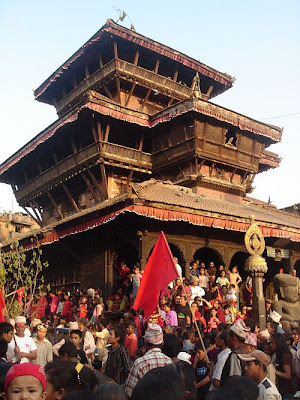 Dattatreya Temple square (also called Tachupal) was once surrounded by Maths, or Hindu ashram-style centres of residential learning. Students came from all over the region to learn traditional Ayurvedic (herbal) medicine in the ornately carved wooden buildings. Now, Pujari Math is a woodcarving museum, and another of the Maths has been transformed into a high-priced tourist restaurant.
Dattatreya Temple square (also called Tachupal) was once surrounded by Maths, or Hindu ashram-style centres of residential learning. Students came from all over the region to learn traditional Ayurvedic (herbal) medicine in the ornately carved wooden buildings. Now, Pujari Math is a woodcarving museum, and another of the Maths has been transformed into a high-priced tourist restaurant. 
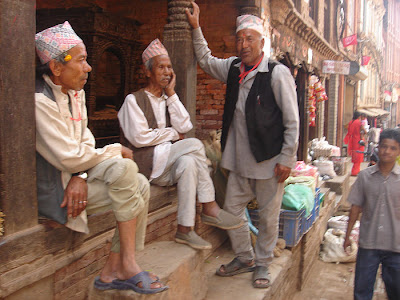
 ::Bisket Jatra is a nine-day blowout festival in Bhaktapur, the second Every day features a different event. This is the raising of the Lingo (Lingam), a sort of Maypole equivalent (fertility/phallic symbol). When the Jesuits arrived centuries ago in their attempts to convert the Newars, they were so happy to see the lingo - they thought Christianity had already come to Nepal. Boy were they wrong....
::Bisket Jatra is a nine-day blowout festival in Bhaktapur, the second Every day features a different event. This is the raising of the Lingo (Lingam), a sort of Maypole equivalent (fertility/phallic symbol). When the Jesuits arrived centuries ago in their attempts to convert the Newars, they were so happy to see the lingo - they thought Christianity had already come to Nepal. Boy were they wrong.... 


 ::Yummy daal bhatt - the Nepali national dish - at the Newa Family Restaurant in Sukul Dhoka - highly recommended. All this for 110NRS (about $1.50).
::Yummy daal bhatt - the Nepali national dish - at the Newa Family Restaurant in Sukul Dhoka - highly recommended. All this for 110NRS (about $1.50). ::The elaborate medieval style lock on a temple door.
::The elaborate medieval style lock on a temple door.
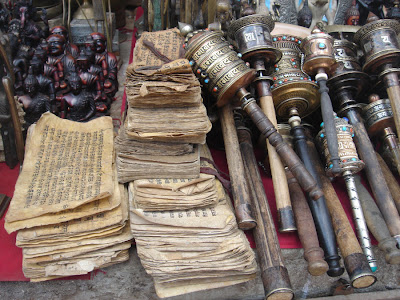 ::The Newars created their own brilliant art, wood carvings (above), metal work and Paubha religious paintings. However, most of what sells in places like Kathmandu, Boudha and Bhaktapur is Tibetan, or should I say "Tibetan." All this is junk created by Nepalis and sold by Nepalis. The real Tibetans are all in hiding from the police these days.
::The Newars created their own brilliant art, wood carvings (above), metal work and Paubha religious paintings. However, most of what sells in places like Kathmandu, Boudha and Bhaktapur is Tibetan, or should I say "Tibetan." All this is junk created by Nepalis and sold by Nepalis. The real Tibetans are all in hiding from the police these days.  ::Despite its image as an overwhelmingly Hindu traditional town, Bhaktapur also has at least one mosque and many Buddhist viharas, including one Theravada Buddhist vihara supported by a Thai donor.
::Despite its image as an overwhelmingly Hindu traditional town, Bhaktapur also has at least one mosque and many Buddhist viharas, including one Theravada Buddhist vihara supported by a Thai donor.



